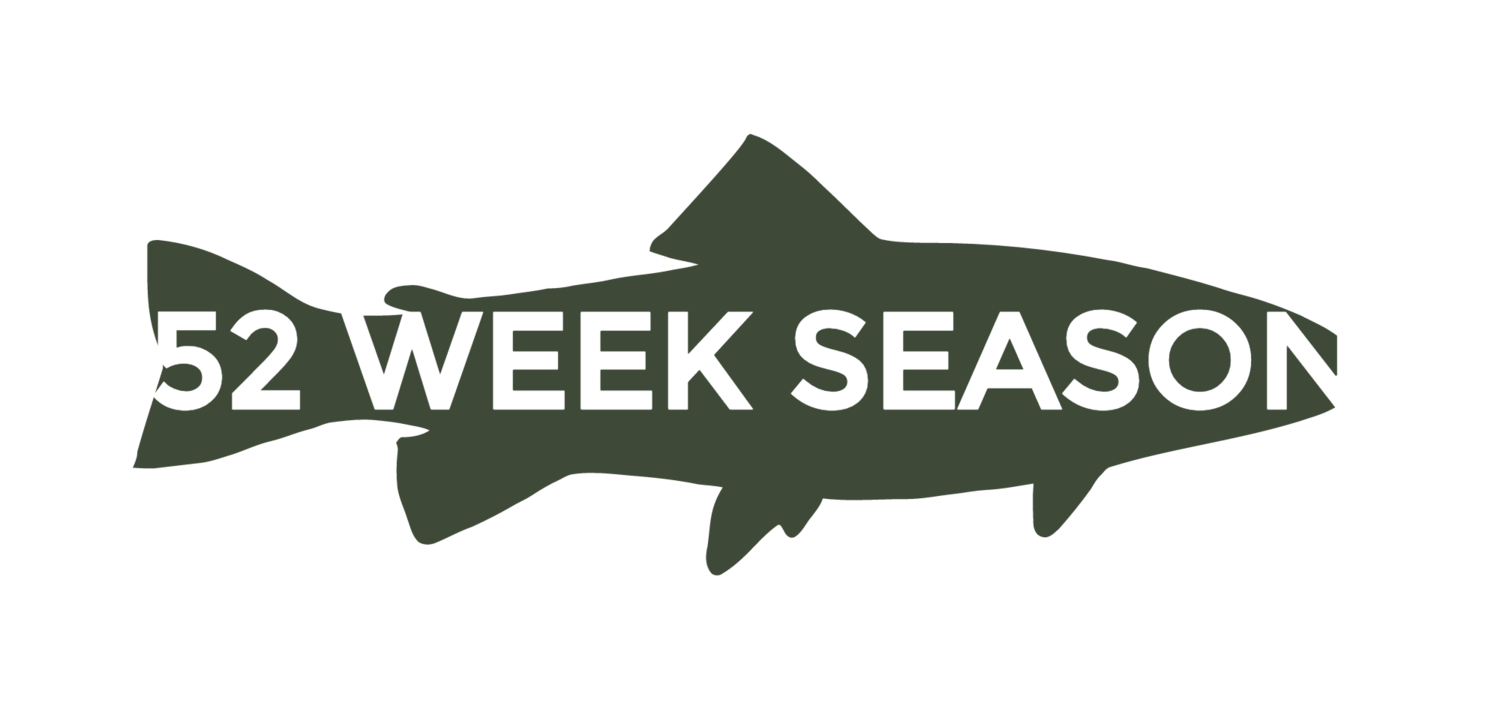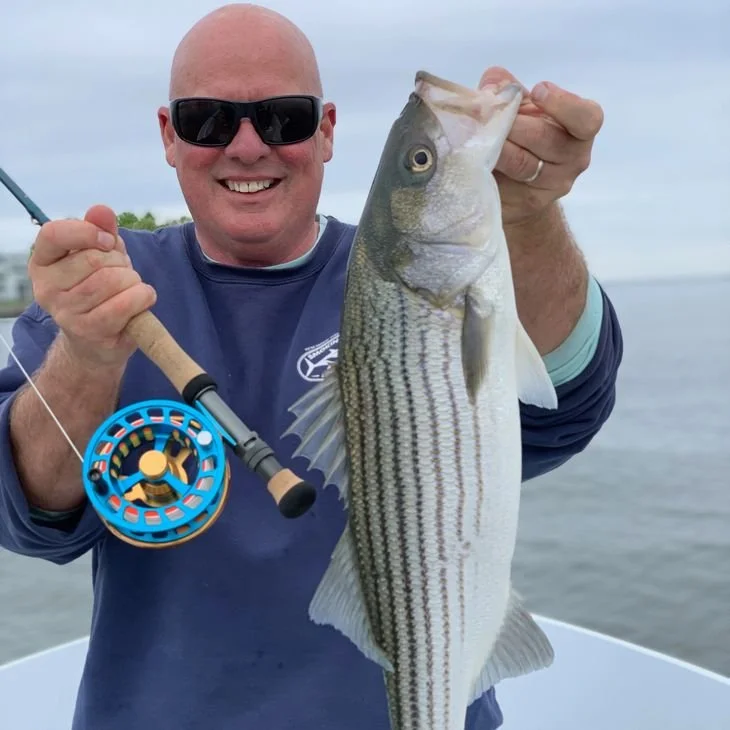Anglers Sports Center: Alex Perez and Mike Fiore
Some dudes are just plain-old fishy. They’re people who fish just seem to gravitate to and always somehow get “lucky.” The truth is that it’s a combination of skill, tactics, and most importantly, a good old-fashioned sixth sense honed from countless days on the water and many more thinking about it.
““You’ll see a mixed bag in February and March and can catch a limit of crappie, limit of yellow perch, and get some white perch mixed in.””
Alex Perez and Mike Fiore are two of the fishiest guys around. Their backgrounds read like an Anglers Journal table of contents. Mike grew up in Maryland catching pickerel and yellows by way of Adirondack lake trout and sunfish, and Alex has camped and fished his way across the state from the Alleghenies to the Atlantic after moving here from Mexico and is most often found in his kayak on Eastern Shore backwaters. Today they are both pro-staff at Anglers in Annapolis.
I sat down recently with Alex and Mike at Anglers to talk primarily late winter and early spring fishing, though we covered pretty much everything from panfish to peacock bass to puppy drum. We talked about the yellow perch run, when it shifts over to white perch, where to find crappie, when largemouth get active, the habits of chain pickerel, and the impact of snakehead on all of these fisheries.
Below are my questions in bold, followed by their answers.
We’re coming on the peak of the yellow perch run. When would you say is the best time to catch them?
Alex: The first stages of pre-spawn in late January or February and then you get into the spawn, which is roughly the two weeks from early March to St. Patrick’s Day. There’s the saying from the old-timers that St. Patrick’s Day is pretty much the peak of yellow perch and beginning of white perch.
How important are weather trends, like if you get a cold front?
Mike: Weather is a super big factor. I remember in past years when we had a warm winter, everybody missed the yellow perch run because it was in January when it was still like 50-60 degrees. People were like, when’s the yellow perch run? It had already happened.
Alex: Also, once you see the movement of the spawn, it doesn’t happen once in the whole state. You get to see it start from the lower Eastern Shore around the Pocomoke River and then creep up to the northern part of the state.
You see how diverse it is. You don’t fish for them the same way in any spot really.
Are they activated by a certain temperature?
Alex: What I’ve noticed is [they’re activated to spawn] in the range of 40-45 degrees water temperature.
There’s a lot I’ve heard too about moon phases, too. Once again, old timers say the full moon dictates when things happen.
So, there’s a lot of old school sayings, but if we’re talking scientific facts, it’s really the temperature. I’ve had it happen at 40 degrees before in the upper Magothy with ice all over the water, where we had to just barely break through to get some open water. The water was hitting 40 degrees, and they were full-on moving through there.
Alex with a solid largemouth
Mike: The other day when we went fishing, it was snowing and 30 degrees and we didn’t catch many. The next day we went, it was sunny and 15 degrees air temperature warmer, and we caught a lot more fish. Being cloudy one day and sunny the next made all the difference.
Do yellow perch migrate?
Alex: Yellow perch don’t move that much and typically stay within the same body of water. They kind of hide in the grass during the summer’s warmer temperatures, and in winter they move to those deeper holes and stay there. Then you see them in the shallows in the spring when they move up to spawn. You’ll see them there full spawning for a month or so, and then they just spread out again.
You mentioned grasses. What kind of habitat do they like to hang out in?
Mike: Pretty much grasses. They love grass. Even during the spawn I feel like there are certain holes with grass where they like just to stage.
I also usually look and try to find deeper holes, even if it’s just a foot deeper. They just kind of like to hang out there. But mainly grass if you can find it, even if it’s not fully bloomed.
Do they like structure like pickerel or bass?
Mike with some yellows
Mike: I’ve caught some on the Choptank where [it feels like] you’re almost bass fishing. You’re throwing jigs and stuff like that around cover, and they tend to be around that. They like to get out of the current too. If the current’s flowing, they’ll be behind it.
What do they eat?
Mike: Minnows, grass shrimp, crab, white perch. In the summer, soft crabs and clams. Really anything.
Alex: I feel like yellow perch more than white perch tend to feed a lot more on smaller fish.
Mike: 90% of the ones I’ve caught when I’ve cut them open had minnows or other small fish in there.
Alex: They’re a little more aggressive [than white perch]. A lot of times when I’m throwing a yellow perch pattern for pickerel, I’ll catch yellow perch. I’ve seen little yellow perch being chased by bigger yellow perch after the spawn.
What lures do you use?
Mike: I like to tie my own jigs with hair or go with plastic curly tail with a tiny paddle.
I’ll start with 3/16 oz. jig and have gone down to a 1/64 oz. when they’re being finnicky.
I always start off with plastic, but sometimes those tougher days I’ll use minnows. Gulp is great, too. I always have that in my bag. It gives them that scent especially when I’ve made little hair jigs out of duck feathers.
Alex: For panfish, you pretty need to have multiple different sizes of jigs. Anything from 1/64, 1/32 and up.
And obviously, bobbers and sinkers. You can go from shallow water when they’re fully on spawning in three to four feet of water at the most to some of those deeper holes in the pre-spawn when you’re fishing 10-15 feet of water and need to get down there.
Without burning some of your best spots, what would you say are some of the best types of places to catch yellow perch?
Bull red on the ‘yak
Alex: For a prime spot to catch both numbers and quality size fish, your best bet is probably the Susquehanna Flats. Of course, that’s mainly fishing by boat because they do stage in such deep water there.
One of the spots which most people don’t talk about or know is the Pocomoke. It is probably the ultimate hidden gem of Maryland. It’s such as long river that once you get up to Snow Hill, there are a couple of areas where you can shore fish. Where exactly? That’s a whole ‘nother animal because locals keep it super quiet. So it’s hard to get any info out of that place unless you’re going and fishing it.
During the spawn, do the males and females have different migration habits?
Mike: Yes, males are the ones that go up the rivers first, and they’re always super thin, and usually a lot shorter and smaller. The females are the ones with the bigger head, the big bellies, and they are a little bit more of the citation fish.
So you’re not actually fishing the spawn, correct?
Alex: Your bigger fish will be pre-spawn.
Mike: And post-spawn. You’re getting all the females that have laid eggs and are on their way back out or the males that are on their way back out.
Alex: You also have waves of fish. There’s a lot of times where we can say it’s over because people keep saying every single fish they’re catching is skinny.
Mike: I’ve had it where people catch tons of females with a bunch of eggs and then a week later, you catch only skinny ones where the females are all spawned-out.
Once the yellow perch run is over, when do you know it’s time to start focusing on the white perch?
Mike: It’s just completely different. One day you can catch a bunch of yellows, and then you go out a week later and you’ll just start to catch more whites and fewer yellows, and then slowly more and more whites.
Alex: It’s really dependent on the body of water you’re fishing. Typically, in most of the Eastern Shore areas you’ll have 100% yellow perch, and as soon as that’s done and it warms up a little bit more, the white perch will move in.
Mike: On others, like the Magothy, you can catch both. People are going down and catching a bunch of white perch [in March].
And there are way more white perch -- I mean, you can go out and fill a five-gallon bucket and catch fish every single cast. Whereas with yellow perch, you might make a few casts before you catch one.
Alex: Their spawn timeframe is a lot longer than the yellows. You’re talking about not two or three weeks, but a whole month or longer.
How about crappie? Do you ever go out fishing solely for crappie, or is it a bycatch?
Tuckahoe yellows
Mike: I’ve fished for them on the Little Choptank while I’m yellow perch fishing. You find schools of crappie and hammer those with the same tactics. They’re not everywhere but you find them, they’re kind of schooled up depending on the time of year.
Do they spawn a little bit later?
Mike: Honestly, the winter is probably the best time. It’s broad to say that, but I’ve caught bigger ones from October to March. It’s also a lot clearer water.
Alex: Pocomoke River is one of those places where you’ll see a mixed bag in February and March and can catch a limit of crappie, limit of yellow perch, and get some white perch mixed in. They’re in deeper water schooled up. Once you find them, you can sit on them for a little while and just pick them off.
You also have some big reservoirs in central Maryland where, if you can get them during the spawn in May, you can get big crappie and lots of them. Loch Raven Reservoir is probably my favorite spot for fishing for them. You’ve also got Liberty Reservoir and Rocky Gorge Reservoir, which are bigger bodies of water and it take a little time to find them. But once you do, it’s like nonstop action.
Do they hang out around structures and ledges like bass?
Alex: In those big bodies of water in winter fishing, you’ll find them in February and March on the dropoffs outside of shallows where they’re staging to move in to spawn. You’ll see that they’re just kind of staging on the outside of the deeper water, sitting there.
You can find there up to late April, May, when they move into the grass flats. You can see them throughout the flat, spawning. It’s pretty awesome seeing that happening.
Mike: For tidal areas like the Little Choptank and Pocomoke, I found that any moving current is best. I’ve been fishing where you catch them literally every cast, and then it’s every third cast, and then it’s completely shut off. You wait around and then the current starts to move again, and then you hammer them again.
Switching gears to another great winter fishery, do you feel that people catch chain pickerel in the winter because that’s the best time to catch them or because there isn’t as much to fish for then?
Mike: They definitely like colder water, and they’re more active in cold versus warm water.
Alex: They are really aggressive during the winter, plus they spawn right before yellow perch. I’d say from pretty much the beginning of November to the beginning of March, you can see them going from pre-spawn to post-spawn.
It’s obviously one of the bigger gamefish that we have locally during the winter. It’s pretty much pickerel and yellow perch -- those are the two options.
It’s an amazing fishery that kind of pushes you to fish through the cold months, and you really get to learn about the area if you’re fishing it during the winter. They’re becoming more popular gamefish for the winter now slowly but surely, because a lot of people thought of pickerel as a trash fish.
We’re lucky to have them in the tidal waters here and in some freshwater ponds and lakes. We have some big pickerel around here for sure.
Where do you find some of the bigger ones?
Alex: Some of the bigger one are in the ponds on the Eastern Shore. We’re talking about 4-6 lb. fish. They really do get big because they’re feeding a lot on bigger baitfish in the ponds.
Mike: You catch more in tidal, but they’ll be bigger in fresh.
Alex: The cool thing about it too is that all the spots we talked about for yellow perch, you're gonna catch pickerel. They attempt to chase the yellow perch and feed on them in a lot of those areas.
Is the style of fishing more like other esox species or like yellow perch?
Alex: Let’s put it this way, it’s bass fishing. It’s mainly jerkbaits, small inline spinners, bigger glide baits, or live bait or live minnows if you're not moving around much. You can also do small swim baits on the bottom, just kind of hopping them on a jig or Texas rig style.
Do you use wire leader with those crazy teeth?
Alex: I personally do the opposite where I downsize the leader to 10-12 pounds. I mean, you're fishing clear water in the winter.
You can create reaction strikes out of them, but most of the time they chase down your bait. They see it, and it's almost like a muskie where they’ll stalk it.
Mike: You’re reeling it in and look down, and whoa, it just comes out and is checking you out.
Alex: A lot of times they act like their bigger cousins [muskie] and they just won’t commit.
Mike: I’ve caught pickerel on lures eight inches long where the fish is 12 inches.
Speaking of bass, I saw you’ve been catching some monster largemouth. When would you say that starts getting really good?
Blackwater snake
Alex: Pre-spawn is pretty much the last few weeks of February to the middle of March. But again, it’s gonna be temperature related.
Pre-spawn in places like the Potomac, Pocomoke, Nanticoke rivers -- places with tidal water -- is a bit earlier.
With ponds and lakes, it’s a bit later. I’d say the middle of March to mid-April is when you really start seeing that pre spawn.
A lot of these bodies or water on the Eastern Shore have some great winter fishing. Probably one of the most productive areas where you can really catch numbers and quality-size fish is during the winter months. When you find them within the body of water and you get some good conditions, you get some good days and quality-size fish out of those places.
Do you fish for snakehead too?
Alex: Oh, heck yea! That’s all I do in the summer. I started doing that with the fly rod on topwater. I only caught probably 12 snakeheads on the fly rod last year. But I’m catching much more subsurface with conventional gear.
Blackwater?
Alex: Yea mostly in Blackwater and also the Patuxent.
I did one of these interviews with the Virginia DGIF biologist John Odenkirk on snakehead, and his theory was that snakeheads do not compete with bass because they operate in shallower water.
Alex: I 100% agree with that, but from my personal experience and talking to locals, it’s dependent on the ecosystem. In the Potomac you have a lot of predator fish like bass. In Blackwater before snakehead were there, there were a few bass and some crappie, but there weren’t many predator fish. As soon as snakehead arrived, not the crappie, yellows, pickerel are all gone. I’ve seen it there and in the Patuxent.
Any big fishing trips coming up?
Alex: I never ends around here. Trout in Tangier, more snakehead, and now I’m getting into trout flyfishing in central Pennsylvania. Oh, and heading down to Florida soon to catch some peacock bass!









